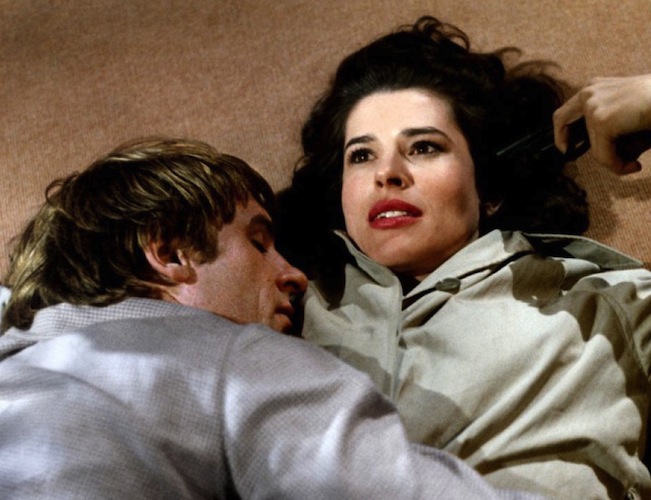Film Review: Essential Truffaut, Part Deux—”The Woman Next Door”
The Museum of Fine Arts’ retrospective of the films of Francois Truffaut approaches its conclusion with another rarely screened late work by this master of 20th-century cinema.
The Films of François Truffaut at the Boston MFA, continuing through December 28.
The Woman Next Door / La femme d’à côté
Thursday at 8 p.m. in Remis Auditorium and on Friday at 5:30 p.m. in Remis Auditorium

“The Woman Next Door” is an unusually potent and unsettling tale of adultery in the French provinces.
By Betsy Sherman
As the fine François Truffaut retrospective (all on 35mm film!) at the Boston Museum of Fine Arts reaches its final weekend, another crucial, rarely screened work will be shown. The Woman Next Door (1981) unites the sublime Gérard Depardieu with big-screen newcomer Fanny Ardant in a combustible drama about the consequences of passion.
The production marked the kindling of Truffaut’s own passion for Ardant. He had seen her in a TV movie and was smitten; subsequently, he cast her as the female lead in The Woman Next Door. Sadly, this would be Truffaut’s next-to-last film (Truffaut and Ardant’s hit-and-miss 1983 comic thriller Confidentially Yours / Vivement dimanche! plays at the MFA on Friday and Saturday). Ardant would be the last love of his life. He was diagnosed with a brain tumor in 1983, the year the couple had a daughter. The lion of the French New Wave died in October 1984 at the age of only 52.
The Woman Next Door is an unusually potent and unsettling tale of adultery in the French provinces. Just like in those old heist movies in which a web of tripwires becomes illuminated by a special kind of light, the film illuminates a series of otherwise invisible connections that can become activated under the right circumstances. These connections transgress conventional moral boundaries.
Bernard (Depardieu), Arlette (Michele Baumgartner) and their son Thomas enjoy the fruits of middle-class prosperity in their refurbished farmhouse in Grenoble. A stone house next to theirs, long vacant, has been rented by Philippe (Henri Garcin) and Mathilde (Ardant). As Bernard and his wife greet the new neighbors, a strange look passes between him and Mathilde. Their respective mates remain oblivious, although each is aware that there was a traumatic break-up in their spouse’s past. Bernard and Mathilde were one of those couples who couldn’t live with each other and couldn’t live without each other, until a definitive (or so they thought) break was achieved.
Bernard, in a vain attempt to resist contact with the neighbor couple, becomes ill-tempered. Mathilde deludes herself that friendship is possible. Two invisible connections—the voyeuristic gaze from a window of one house to a window of the other, and the connection by telephone—lead to the inevitable contact of the flesh. Bernard and Mathilde rendezvous at a run-down hotel (presumably, none of their social set would be there) and resume their amour fou.
This is a story of addiction, chemical and emotional, not to sex, but to each other. Neither Bernard nor Mathilde expresses guilt in regards to their spouse (for a while, at least); it’s possible that each believes that this “fix” they get from each other makes them a whole person, and therefore an even better husband or wife. Of course, they’re mad to think the affair is something they can control.
The bull-like Depardieu and the tall, angular Ardant bring to their roles a life force such that the seams that hold together Bernard and Mathilde’s bourgeois existence threaten to burst (it’s painfully comic that Bernard’s job, training oil tanker captains on scale models in an artificial sea, makes him look like a mock Atlas). In the movie history pantheon from which Truffaut regularly drew inspiration, they suggest the doomed lovers exhumed from the Pompeii ruins in Robert Rossellini’s Voyage to Italy (a film championed by Truffaut when he was a critic). Arlette and Philippe, the mad lovers’ spouses, are sympathetic, but are mere mortals.
The Woman Next Door is framed by narration from Madame Odile Jouve (Véronique Silver), owner of the tennis club to which the couples belong. When she was young and despondent over a heartbreak, Odile threw herself from a window. She did not die, but lost a leg, and now wears a prosthetic and uses a cane. It may be a sign of Truffaut’s limited imagination, or of not transcending his generation’s prejudices, that the middle-aged disabled woman is depicted as being merely a spectator of the romantic sphere (her closest relationship is with a gay man). But her wise, non-condemning perspective is essential to this story. Look back at Truffaut’s romantic obsessives and you’ll end up with a pile of pretty corpses. With Mme. Jouve, the auteur gives us a human-scale survivor of the romantic trenches.
Betsy Sherman has written about movies, old and new, for The Boston Globe, The Boston Phoenix, and The Improper Bostonian, among others. She holds a degree in Archives Management from Simmons Graduate School of Library and Information Science. When she grows up, she wants to be Barbara Stanwyck.
Tagged: Fanny Ardant, Francois Truffaut, Gerard Depardieu, Museum of Fine Arts
